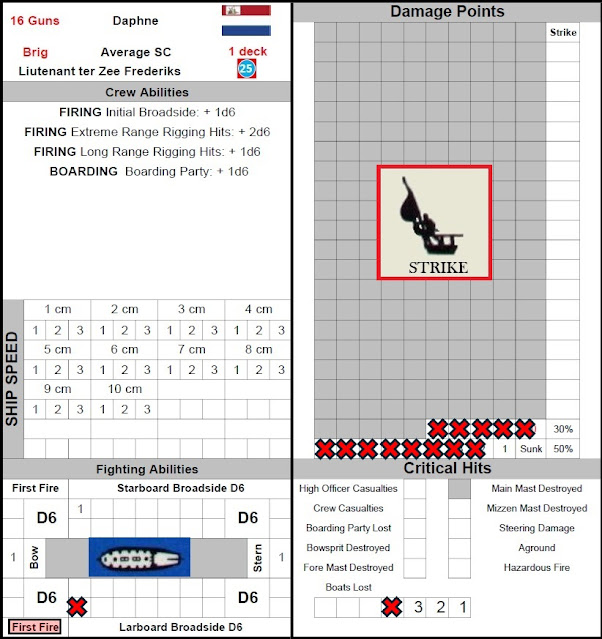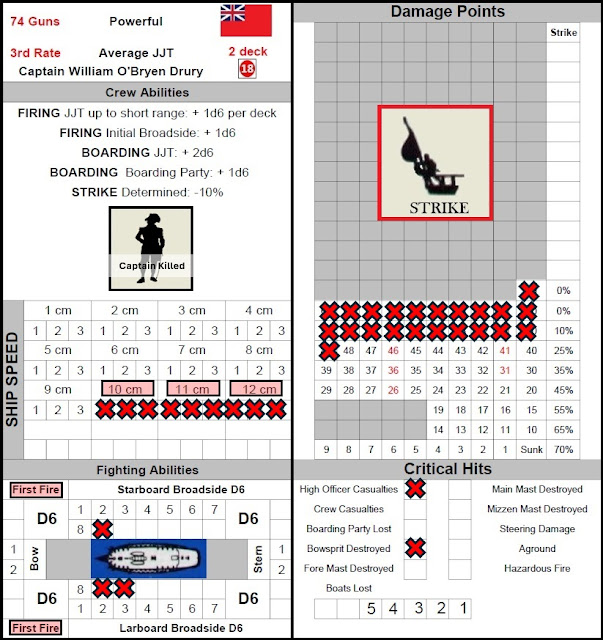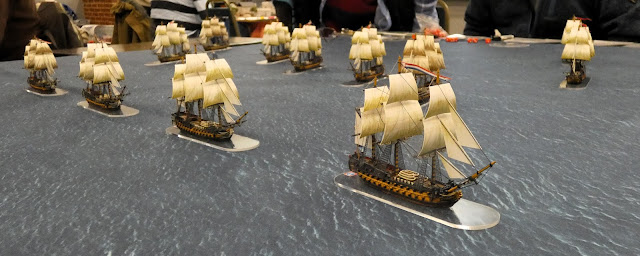The previous six months has seen me focussing on building the British and Batavian Dutch fleets that fought the Battle of Camperdown on the 11th October 1797 in 1:700th scale using the range of models from Warlord Games' Black Seas collection.
 |
| JJ's Wargames - All at Sea, Battle of Camperdown - Project Build, Part Six |
As well as documenting the progress of this project build on my personal blog 'JJ's Wargames' I have been keen to try out ideas for playing the battle with a new set of fleet rules, 'Far Distant Ships' (FDS) by David Manley whilst also preparing the option for using the tried and trusted Kiss Me, Hardy (KMH) rules where time permits to play a longer game.
 |
| JJ's Wargames - Battle of Camperdown - The Leeward Division Attacks, Far Distant Ships |
You can follow the progress too-date with the project build and the recent play-test of FDS in the links above.
My original plan was to try out some other ideas with FDS at club, but with the number of folks wanting to play and keen to keep everyone involved, something my current collection using FDS would struggle to do, I opted to play the same scenario recreating the attack on the Batavian rear by the British Leeward Division, seen in the illustration and map below, using KMH to compare and contrast the games those rules will produce.
 |
| A primary document illustrating the developing British attack on the Batavian line at Camperdown, with our game focussing on the attack of the British leeward division as highlighted |
The set up uses the ships identified in the plan below. leaving out the British fourth-rate Adamant, not really needed given the superiority of the British force, or any of the British light ships for that matter.
 |
| The plan illustrating the primary ships involved in this battle within a battle at about 12.30 on the 11th October 1797. |
The table below illustrates the set up, with the Batavian rear, drawn up in line of battle to the left, with the 40-gun frigate Monnikkendam and the 16-gun brig Daphne acting as a second line and ordered to engage any attempts by the British to penetrate the battle-line.
On the opposite side are the British leeward division led by their flagship HMS Monarch 74-guns bearing down on the enemy line in line abreast (well sort of), not quite in 'Spithead Review' order given the necessity placed on them to close with the enemy quickly to prevent them from edging into the shallows beyond, that would better enable the more shallow drafted Dutchmen to escape battle.
 |
| The plan and panorama brought to life on the table as the battle commences. |
As in the previous game the Batavians were accorded the benefit of superior gunnery given the training they had indulged in whilst blockaded in their home port of the Texel, in this game fighting as 'San Culottes' under KMH to reflect their lesser sailing abilities compared to the British but with their gunnery upped by one class, thus for example seeing an Average Sans Culottes crew firing as an elite crew.
Similarly, to reflect the Batavian captains reports of having to close lower gun ports on the leeward side because of the effects of the wind, we had them test prior to firing their leeward guns for said effects with a simple die roll that would see ports closed on a score of 1, 2 or 3 and a partial broadside resulting.
 |
| The Batavian line maintains its heading and holds its fire as the British bear down. |
For the British, we played a test to see if captains would obey the signal to pass through the enemy line to leeward with a D6 test, with ships failing on a 1 or 2, the Monarch on a 1, for which a failed test would see the affected ship turn away and engage their opponent on the windward side.
 |
| The infamous Captain John Williamson |
In addition we had the 'battle-shy', Captain John Williamson, commanding HMS Agincourt 64-guns, modelled by having said ship turn away to windward once withing medium gunnery range, only able to come closer to any enemy vessel that had struck previously.
 |
| HMS Monarch opens the British account with a daring short range bow-chaser pop at the Batavian flag ship Jupiter |
With a quartering wind the British barrelled along, to come within short range in about three turns of play, with the Batavians holding their fire, not able to take advantage of the normal Sans Culottes advantages of firing at the rigging, as this was not in their doctrine, with all the added bonuses better suited to firing into British hulls instead.
 |
| It was not long in coming, as the Jupiter acknowledged the British salute with one of her own |
With some contempt, the two British 74's, Monarch, and Powerful closed to short range with their bows pointing at Batavian broadsides yet to open fire, gambling that the next opportunity to fire would see the appropriate chit drawn after the ships concerned had moved away presenting their stern galleries for a following rake.
As if to underline the contempt, the Monarch blasted the Batavian flagship, Jupiter, with her brass bow-chasers, only to get a full salute back at short range, the gamble having not quite paid off.
The Monarch got off comparatively lightly with the Jupiter failing to convert a critical hit result to add to the pain of her initial broadside, easily shaking off the resulting strike test for taking a bow rake on her approach.
However the Powerful wasn't so fortunate, taking a well directed broadside from the Haarlem following the Jupiter that caused severe damage with a critical hit resulting in high officer casualties that also saw Captain O'Bryen Drury killed, (I include a test for captain's being killed or wounded whenever a ship get's a 'high officer casualties' result from the critical hits table, thus adding to the narrative of the game) well illustrating the respect needed for Batavian gunnery.
 |
| The two flagships Monarch and Juno dishing out the short range broadsides with the Batavian ship carrying a strike test marker |
The two leading British third-rates heralded the wave-like attack of the British line as one by one they passed their test to pass through the Batavian line issuing passing stern and often bow rakes to their nearest opponents that left the Batavian line reeling under this first fire, with the two fourth-rates, Delft and Alkmaar bringing up the rear amply illustrating the obsolescence of this rate to take its place in the line of battle, both having their helms shot away in critical hit damage that added to the hits already sustained.
The passing rakes were leaving the Batavian line tottering on strike tests as their shattered ships decided whether they would continue to resist, with most passing the test but now having to face the contest fought out on their larboard side.
The two flagships began the contest battering each other at short range in a test of will as to who would concede first, that would see the Jupiter battered into submission over the next couple of turns, losing her main mast and half her guns as the Monarch's got into the rhythm of their gunnery to force the Batavian flag to strike
Behind the Director came the Russell 74-guns, Monmouth 64-guns and the Montagu 74-guns with the first two dismantling the Batavian 56-gun fourth-rates, Delft and Alkmaar with raking fire, causing the latter to strike almost immediately after the punishing fire destroyed her helm and knocked out half her battery of guns.
 |
| The Cerberus 68-guns makes good her escape as the Agincourt stands off with the Monarch just off her larboard side overseeing the Batavian surrender |
 |
| The British attack reaching its climax with the Montagu, Russell and Monmouth battering the two Batavian 56-gun fourth-rates Alkmaar and Delft as they prepare to pass through their line |
There are not many historical sea fights involving ships of the line and the smaller fifth-rates, sixth-rates and lesser vessels exchanging fire, with notable exceptions such as the Battle of the Nile when the 32-gun French frigate Sérieuse unwisely opened fire on the British 74-gun third-rates Goliath and Orion, with the latter reducing the frigate to a smoking wreck with a single close broadside in response.
Likewise the Battle of Camperdown was a notable exception, with the Batavian light ships used as a second line to support their main battle line, with one of the Batavian brigs reported sunk in British log books from the battle after receiving return fire.
The fire from the Daphne barely scratched the hull of the Russell, however the same couldn't be said for the Daphne as the 32-pounder shot shredded the hull of the brig, leaving a floating mass of matchwood and sealing the defeat of the Batavian rear with just the Cerberus 68-guns and the frigate Monnikendam 40-guns able to escape the table, leaving the British leeward division free to lend their support to the more hard-pressed windward division under Admiral Duncan further along the line of battle.
As is my usual practice with my games using KMH, I like to record the damage the players capture on their ship record cards, which help to underline the outcome of any tabletop action and the narrative created, by the damage inflicted on the respective fleets.
 |
| The Russell 74-guns, closest to camera, lowers boats to rescue the survivors of the sinking Daphne, now struck, whilst the two surviving Batavians break contact. |
The Batavian flagship Jupiter's Ship Record Card (SRC) seen below is illustrative of the battering received once the British opened fire at short range often starting with a stern rake and finishing off the job in another two turns of battle with short range broadsides, her opponent being the British 74-gun Monarch.
 |
| The Jupiter battered into submission by Monarch's close range fire. |
 |
| As with Jupiter, the hull of the Alkmaar is absolutely shattered, easily explaining her decision to strike. |
 |
| Like her sister fourth-rate, the Delft is equally battered, losing her mizzen mast from the passing stern rake. |
 |
| The brave, perhaps foolhardy little brig Daphne illustrates why unrated vessels should refrain from tackling anything much larger than a small sixth rate, that alone a British 74-gun third-rate. |
 |
| The Monarch made short work of the Jupiter once she had passed her stern, taking most of the damage recorded here from a bow rake by the Batavian in her approach |
 |
| The Powerful carries the damage from her bow rake received from the Haarlem which left her captain dying and impacted on her ability to rally from the subsequent strike test. |
It was great fun reacquainting myself with KMH last played back in October at the NWS meeting in Yeovilton playing the Bantry Bay scenario.
Compared with FDS the game was very different, with KMH putting the players firmly on the quarterdeck of each ship under their command and not quite catching the same feel of playing at the level of an Admiral or Commodore created by the former.
The result was the same, closely following the historical account if you overlook the striking of Powerful with both games giving a very strong narrative to the play with lots of drama and decision points for the players.
That said rules are indeed like golf clubs, designed for a specific job in mind, and FDS is a perfect compliment to recreating a large fleet action in a day of play, whereas KMH is perfectly positioned for squadron level and single ship actions despite our having successfully used it for Trafalgar, where it will give a very entertaining game for multiple players, but where FDS will, I think, give a better portrayal of the battle from the perspective of a senior commander.
Thank you to Ian, Ian T. Sam, Capt. Steve, Paul and Lawrence for creating all the fun and drama in what was a very entertaining game.
All the models are from the Warlord Games Black Seas range and the sea cloths from Tiny Wargames.
JJ













No comments:
Post a Comment